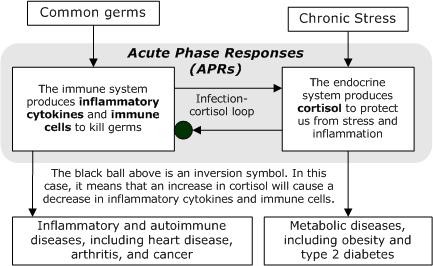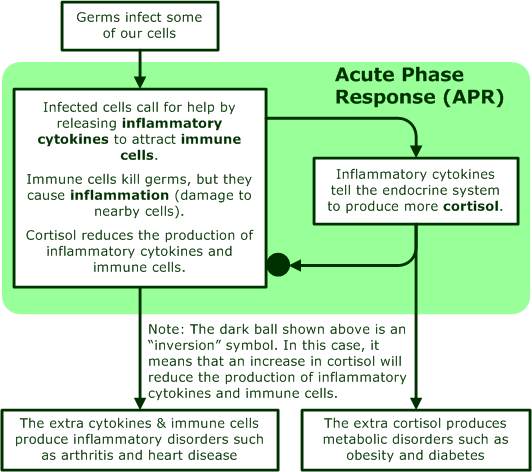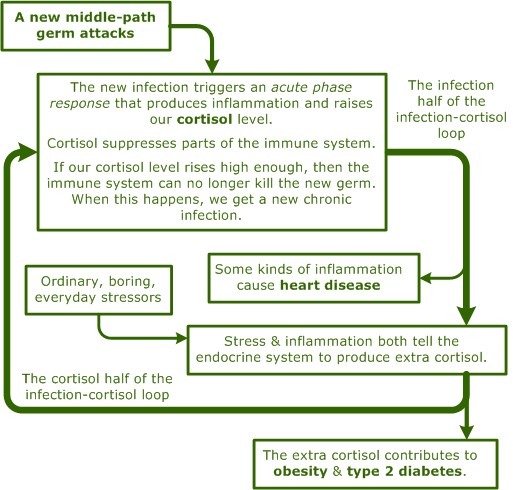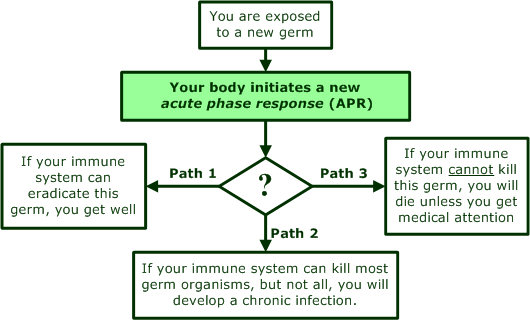I have three descriptions of the infection-cortisol loop that I have to merge.
Chronic infections
This chapter will discuss infections, with an emphasis on how we acquire chronic infections.
Infection-Cortisol Loops 1
Soon after my heart attack I learned that the body produces inflammation to kill microbes and cortisol to limit inflammation. This is usually called an acute phase response (APR), but it continues as long as the infection lasts, so chronic acute phase responses are common. Infection-cortisol loops are an integral part of every APR. They work as shown blow.

It seemed obvious from the instant I saw this arrangement that microbes would evolve to exploit the infection-cortisol loop, and they have.
If the infection-cortisol loop seems too simple to explain anything, don't worry, there's more to it. Mother Nature invented the loop for fish 500 million years ago and She has been fine-tuning it ever since. I would have to make a drawing the size of a wall to show the details, but the drawing above shows the main elements.
The chief benefit of the infection-cortisol loop is that improves our reproductive success by protecting us from acute infections. It keeps most of us alive and active long enough to bear and raise children.
The chief consequence of the loop is that it allows chronic infections to smolder, and each chronic infection makes us more susceptible to the next one. Consequently, our infectious burdens increase at an exponential rate as we get older.
About the time we're old enough to have grandchildren, Mother Nature abandons us and we begin to accumulate the aches, pains, and frailty associated with old age. We start to fall apart.
Infection-cortisol loops 2
Cells "talk" to each other by exchanging chemicals called cytokines. When cells are infected by a new germ, they start an acute phase response (APR) by sending inflammatory cytokines to the immune system. The drawing below shows how APRs flood the body with cytokines, immunocytes (white blood cells), and cortisol.

Cytokine cascades. Infected cells release inflammatory cytokines into the blood stream. The immune system responds by sending immune cells to the infected cells. When the immune cells arrive, they start killing germs, but they also inflame (injure) healthy cells near the infected ones.
The inflamed cells send out cytokines that attract still more immune cells. More cells are inflamed, and more cytokines are released to call for still more immune cells. This process is called a cytokine cascade, and it is a normal part of every new APR. Cytokine cascades do a good job of killing germs, but they cause most of the nausea, pain, and fever that we associate with infections.
Cytokine storms. Cytokine cascades sometimes go wild and grow into cytokine storms. A cytokine storm can kill an otherwise healthy person in about three days. To prevent cytokine storms, three cytokines--IL-1, IL-6, and TNF-alpha--tell the endocrine system to produce extra cortisol. Cortisol reduces the production of immune cells and prevents cytokine cascades from becoming cytokine storms. (en.wikipedia.org⁄wiki⁄Cortisol)
Cortisol protects us from cytokine storms, but it has some nasty side effects, including immune suppression, obesity, and type 2 diabetes. (en.wikipedia.org⁄wiki⁄Cytokine_storm)
Infection-cortisol loops 3
The immune system uses inflammatory cells and chemicals to kill germs, and the endocrine system produces cortisol to protect us from inflammation. The result is an infection-cortisol loop that kills most germs quickly without causing us too much fever or pain. There are only a few germs, like the Ebola virus, that overwhelm the infection-cortisol loop and kill us quickly.
Some germs benefit from the extra cortisol more than they are harmed by inflammatory cells and chemicals. These germs often cause chronic infections that keep us in a state of mild inflammation and mild hypercortisolism year after year. In The Potbelly Syndrome (www.potbellysyndrome.com) we called these germs "middle-path" germs because we can't kill them and they can't kill us.
To be more specific, middle-path germs can't kill us right away. They do kill us, but they do it slowly and painfully; they do it by making us old. The drawing below shows what happens each time we are exposed to a new middle-path germ.

Chronic infections
Not all germs cause infections; there are hundreds of germs that live on us, or in us, without hurting us. Some of them may actually help us. The germs we are interested in are pathogens, the germs that harm us. More specifically, we are interested in pathogens that cause chronic infections.
All infections start with APRs, and in their early phases APRs are pretty similar to each other. That's why so many infections start with runny noses and sore throats. Within a few days, each APR begins to follow one of three paths:
- Path 1. Our immune systems eradicate the invading germs in a few days or weeks. Usually, we don't know that we have been infected. This is the path most infections follow.
- Path 2--the middle path. Our immune systems kill most, but not all, of the invading germs. The surviving germs cause chronic, low-level infections. The cytokine cascade becomes a cytokine dribble. The herpes viruses are typical middle-path germs.
- Path 3. Infections overwhelm our immune systems and kill us quickly (unless we get medical attention). Except for pneumonia, fast-acting, fatal infections are rare in wealthy, industrialized countries. The drawing below shows all three paths.

Infectious burden. The sum of our infections is called our infectious burden (sometimes called pathogen burden).We usually add a couple of herpes infections to our infectious burden before we start school, and we pick up a few more before we finish school. Then we start swapping infections with people at work. Since these infections last forever, our infectious burden grows as we get older.
I'm guessing that we will acquire roughly a dozen chronic infections in a long life, but no one knows the real number. However many there are, each one reduces the length and quality of our lives.
APR burden
We have "APR burdens" that are proportional to our infectious burdens. The cytokines, immune cells, and cortisol produced by our APRs contribute to our inflammatory and metabolic disorders.
Two important middle-path germs
There are two important germs that wind up in the infectious burdens of most people. One is a bacterium called Chlamydophila pneumoniae (CPN, en.wikipedia.org⁄wiki⁄Chlamydophila_pneumoniae) and the other is a herpes virus called cytomegalovirus (CMV, en.wikipedia.org⁄wiki⁄Cytomegalovirus). Each of these germs is linked to obesity, diabetes, heart disease and 100+ other disorders. They both weaken our immune systems and make us more susceptible to other germs. As common as they are, diagnosing and treating them is difficult.
More information about infections
I love books, but websites have one major advantage over books; they can include direct links to related material. This website contains links to some of the abstracts and reports that have shaped my thinking.
One of the biggest influences on me was the work of evolutionary biologist Paul Ewald. His book Plague Time explains why many diseases we attribute to genetics or the environment are actually caused by infections. In February of 2008, Amy Proal interviewed Professor Ewald. Its at bacteriality.com⁄2008⁄02⁄11⁄ewald⁄. If you have any chronic disease, you should read this interview.
PubMed contains references to millions of medical papers from all over the world. It lists, for example, more than 15,000 studies that mention acute phase responses. PubMed is at: www.pubmed.gov. Many of the references provided by PubMed, like the ones listed below, have abstracts attached to them.
Fernández-Real JM, Ferri MJ, Vendrell J, Ricart W. Burden of infection and fat mass in healthy middle-aged men. Obesity (Silver Spring). 2007 Jan;15(1):245-52.
Nabipour I, Vahdat K, Jafari SM, Pazoki R, Sanjdideh Z. The association of metabolic syndrome and Chlamydia pneumoniae, Helicobacter pylori, cytomegalovirus, and herpes simplex virus type 1: the Persian Gulf Healthy Heart Study. Cardiovasc Diabetol. 2006 Dec 1;5:25.
Ewald PW. Evolution of virulence. Infect Dis Clin North Am. 2004 Mar;18(1):1-15. Review.
Verkerk MS, Visseren FL, Paul Bouter K, Diepersloot RJ. Acute-phase response of human hepatocytes after infection with Chlamydia pneumoniae and cytomegalovirus. Eur J Clin Invest. 2003 Aug;33(8):720-5.
Vogeser M, Zachoval R, Felbinger TW, Jacob K. Increased ratio of serum cortisol to cortisone in acute-phase response. Horm Res. 2002;58(4):172-5.
Espinola-Klein C, Rupprecht HJ, Blankenberg S, Bickel C, Kopp H, Rippin G, Victor A, Hafner G, Schlumberger W, Meyer J; AtheroGene Investigators. Impact of infectious burden on extent and long-term prognosis of atherosclerosis. Circulation. 2002 Jan 1;105(1):15-21.
Rupprecht HJ, Blankenberg S, Bickel C, Rippin G, Hafner G, Prellwitz W, Schlumberger W, Meyer J; AutoGene Investigators. Impact of viral and bacterial infectious burden on long-term prognosis in patients with coronary artery disease. Circulation. 2001 Jul 3;104(1):25-31.
Boss B, Neeck G. Correlation of IL-6 with the classical humoral disease activity parameters ESR and CRP and with serum cortisol, reflecting the activity of the HPA axis in active rheumatoid arthritis. Z Rheumatol. 2000;59 Suppl 2:II⁄62-4.
Williams GC, Nesse RM. The dawn of Darwinian medicine. Q Rev Biol. 1991 Mar;66(1):1-22. Review.